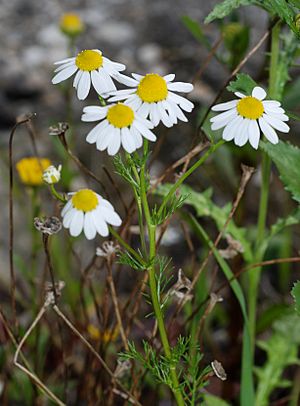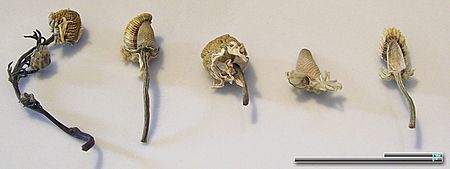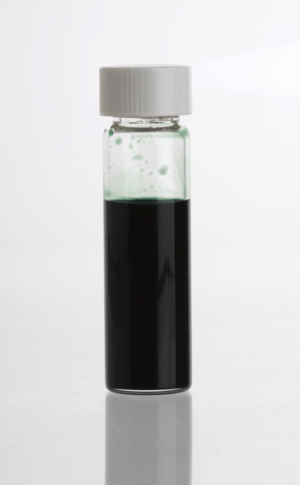Matricaria chamomilla facts for kids
Quick facts for kids Matricaria chamomilla |
|
|---|---|
 |
|
| Scientific classification | |
| Genus: |
Matricaria
|
| Species: |
chamomilla
|
| Synonyms | |
|
Chamomilla chamomilla (L.) Rydb. |
|
Chamomile, also known as German chamomile, is a popular plant often used in herbal teas. Its scientific name is Matricaria chamomilla. It's an annual plant, which means it lives for only one growing season. Chamomile belongs to the Asteraceae family, which includes daisies and sunflowers. People mostly use chamomile to help with tummy troubles and skin irritation.
Contents
About Chamomile Plants
German chamomile is part of the Asteraceae family. It originally came from southern and eastern Europe. Today, you can find this plant growing all over the world.
What Chamomile Looks Like
Chamomile plants have stems that grow straight up. They can reach a height of about 15 to 60 centimeters (6 to 24 inches). The leaves are long, narrow, and feathery.
The flowers grow in small bunches called flower heads. Each flower head has white petals, called ray florets. In the center, there are many tiny yellow flowers, called disc florets. The middle part of the flower head is hollow and doesn't have scales. This helps you tell German chamomile apart from other similar plants.
Chamomile flowers bloom in early to mid-summer. They have a strong, sweet, apple-like smell.
Chamomile's Blue Oil
The flowers contain a special blue essential oil. This oil gives chamomile its unique smell and useful properties. The blue color comes from a substance called chamazulene. This is why chamomile is sometimes called "Blue Chamomile."
The Name Chamomile
The word "chamomile" comes from ancient Greek words. "Chamai" means "on the ground," and "melon" means "apple." So, "chamomile" means "earth-apple." It got this name because the plant smells a bit like apples.
Chamomile Through History
People have used chamomile plants for medicine for a very long time. They were used in Ancient Egypt and in ancient Greece and Rome. Some old Germanic tribes also knew about chamomile before they had written language. It's sometimes hard to know exactly which type of chamomile plant was used back then.
Long ago, a Roman writer named Pliny the Elder talked about three kinds of chamomile. Later, in the time of Charlemagne, chamomile was grown in gardens at monasteries.
How Chamomile is Used
In Traditional Medicine
German chamomile is often used in herbal medicine. You can drink it as an herbal tea. It is known to help with stomach and intestinal cramps.
What's Inside Chamomile
Scientists have found more than 120 different chemicals in chamomile flowers. Many of these are in the essential oil. Some important chemicals include bisabolol, farnesene, chamazulene, apigenin, and quercetin.
Possible Side Effects
Chamomile is related to ragweed. If you have allergies to ragweed, chamomile might cause allergy symptoms for you too. It also contains a substance called coumarin. This means you should be careful if you are taking certain medicines, especially those that affect blood clotting.
It's very rare, but drinking a lot of chamomile tea might cause a little nausea. Even more rarely, some people might get a rash. In very rare cases, a severe allergic reaction has been reported. If you have concerns, it's always best to talk to a trusted adult or doctor.
Growing Chamomile
Chamomile is a tough plant that doesn't need special soil. It grows best in balanced soil with good topsoil, but it can grow in many different types of soil. Wild chamomile often grows in sandy or loamy soils that are a bit acidic.
Planting Chamomile Seeds
Chamomile seeds are very tiny. Farmers often use special machines to plant them in rows. The ground needs to be flat and free of weeds before planting. After planting, the soil is pressed down firmly. This helps the tiny seeds touch the soil, which is important for them to sprout. Chamomile needs a lot of moisture when it's young. Seeds usually start to sprout in 1 to 2 weeks.
Farmers can plant chamomile in the autumn or in the spring. Planting in autumn usually gives the biggest harvests. If planted in autumn, the flowers usually start to bloom around late May or early June. Planting in spring allows farmers to spread out their work. Spring planting happens between March and May. However, planting later in spring can lead to smaller harvests and more pests.
Some farmers let chamomile reseed itself. After the last harvest, the plants are cut, and the seeds fall to the ground. These seeds sprout in September, creating a thick layer of plants that helps stop weeds from growing.
Taking Care of Chamomile
Chamomile doesn't need a lot of fertilizer. Too much nitrogen can make the plant grow too much stem instead of flowers. Potassium is important for strong stems. Farmers usually add a balanced amount of nitrogen, phosphorus, and potassium. It's best not to use organic fertilizers directly on chamomile flowers if they are going to be used for medicine, to avoid bacteria.
Pests and Weeds
Young chamomile plants grow slowly, so it's important to control weeds. Farmers often prepare the soil carefully to remove weeds before planting. After the plants sprout, weeds are removed by hand or with machines.
Aphids are tiny insects that can harm chamomile plants. They can slow growth and attract other insects like ladybugs. These insects can be hard to remove from the flowers after harvest, which can affect quality.
Other common plant diseases that can affect chamomile include downy mildew, powdery mildew, and rust.
Harvesting Chamomile
Chamomile plants often flower 2 to 3 times a year. This means farmers can harvest them multiple times. A single flower takes about 20 to 25 days to develop.
When to Harvest
The best time to harvest is when the flowers are fully open. This is when they have the most essential oil. The white petals should be pointing straight out or slightly downwards. Farmers pay close attention to this to get the best quality flowers.
How Chamomile is Harvested
Chamomile can be harvested by hand. People might pluck the flowers with their fingers or use simple tools like combs or shovels. This is common for small gardens or wild chamomile.
For larger farms, machines are used to harvest the flowers. These machines are designed to be gentle so they don't damage the flowers. They often cut off the flower heads along with a small part of the stem. Even with machines, the harvested flowers are still very high quality. Some machines use rotating drums with sharp combs to gently cut the flower buds.
After Harvest
After harvesting, chamomile flowers contain a lot of water. They need to be dried quickly to prevent them from spoiling. Drying should start within two hours of harvest.
Drying Chamomile
Chamomile can be dried in the sun or under a roof. Large farms use special drying machines. It's very important that the flowers are never heated above 40°C (104°F). This keeps their quality high. The flowers are dried until they have only about 10-11% water left.
Sorting Chamomile
After mechanical harvesting, there might be some small pieces of stem mixed with the flowers. These are often sorted out before or after drying using special screens. If harvested by hand, sorting usually happens after drying.
Making Chamomile Oil
One important reason to grow chamomile is to get its chamomile oil. This oil is used in medicines and other products. It's usually taken from fresh flowers and stems through a process called distillation. A key ingredient in chamomile oil is bisabolol, which can make up a large part of the oil.
Images for kids
See also
 In Spanish: Manzanilla alemana para niños
In Spanish: Manzanilla alemana para niños






